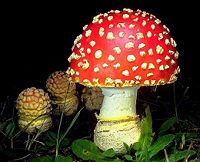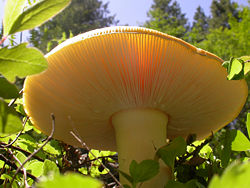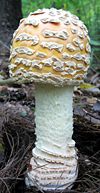Amanita muscaria: Difference between revisions
imported>Ro Thorpe |
mNo edit summary |
||
| (3 intermediate revisions by 3 users not shown) | |||
| Line 4: | Line 4: | ||
| name = ''Amanita muscaria'' | | name = ''Amanita muscaria'' | ||
| image = Amanita_muscaria(tfl-c0229-35).jpg | | image = Amanita_muscaria(tfl-c0229-35).jpg | ||
| regnum = [[Fungi]] | | regnum = [[Fungus|Fungi]] | ||
| phylum = [[Basidiomycota]] | | phylum = [[Basidiomycota]] | ||
| classis = [[Agaricomycetes]] | | classis = [[Agaricomycetes]] | ||
| Line 17: | Line 17: | ||
'''''Amanita muscaria''''', commonly known as the '''fly agaric''', is a [[psychoactive]] [[fungus]]. It is known as the fly agaric for its ability to kill houseflies when combined with milk. The reason for this is that flies are attracted to the milk because it is so sweet. When they drink the milk they feel the effects of the mushroom and begin to act intoxicated. They fly into walls and windows or just faint and can be disposed of.<ref>[Amanita muscaria var. muscaria (red Fly Agaric)." Erowid. 13 May 2009 <http://www.erowid.org/plants/amanitas/amanitas_muscaria_muscaria.shtml>.]</ref> The common hallucinogenic compounds found in ''Amanita muscaria'' are [[ibotenic acid]] (α-amino-3-hydroxy-5-isoxazoleacetic acid) and [[muscimol]] (3-hydroxy-5-aminomethyl-1-isoxazole). | '''''Amanita muscaria''''', commonly known as the '''fly agaric''', is a [[psychoactive]] [[fungus]]. It is known as the fly agaric for its ability to kill houseflies when combined with milk. The reason for this is that flies are attracted to the milk because it is so sweet. When they drink the milk they feel the effects of the mushroom and begin to act intoxicated. They fly into walls and windows or just faint and can be disposed of.<ref>[Amanita muscaria var. muscaria (red Fly Agaric)." Erowid. 13 May 2009 <http://www.erowid.org/plants/amanitas/amanitas_muscaria_muscaria.shtml>.]</ref> The common hallucinogenic compounds found in ''Amanita muscaria'' are [[ibotenic acid]] (α-amino-3-hydroxy-5-isoxazoleacetic acid) and [[muscimol]] (3-hydroxy-5-aminomethyl-1-isoxazole). | ||
{{Image|Amanita muscaria gills.jpeg|left|250px|Gills of ''Amanita muscaria''}} | {{Image|Amanita muscaria gills.jpeg|left|250px|Gills of ''Amanita muscaria''}} | ||
It is a fairly large [[mushroom]] with a bright red [[cap]] that ranges from 8-20 cm in diameter. The white spots on the cap are remains of the [[universal veil]], a membrane that covers the [[mushroom]] at a young age. A [[partial veil]] usually forms a skirt-like ring on the upper region of the [[stalk]]. The [[stalk]] or [[stipe]] is white or cream in color ranging from 5-20 cm high and 1-2 cm wide. The [[gills]] are free or slightly attached and are white in color.<ref>[Amanita muscaria var. muscaria (red Fly Agaric)." Erowid. 13 May 2009 <http://www.erowid.org/plants/amanitas/amanitas_muscaria_muscaria.shtml>.]</ref><ref> | It is a fairly large [[mushroom]] with a bright red [[cap]] that ranges from 8-20 cm in diameter. The white spots on the cap are remains of the [[universal veil]], a membrane that covers the [[mushroom]] at a young age. A [[partial veil]] usually forms a skirt-like ring on the upper region of the [[stalk]]. The [[stalk]] or [[stipe]] is white or cream in color ranging from 5-20 cm high and 1-2 cm wide. The [[gills]] are free or slightly attached and are white in color.<ref>[Amanita muscaria var. muscaria (red Fly Agaric)." Erowid. 13 May 2009 <http://www.erowid.org/plants/amanitas/amanitas_muscaria_muscaria.shtml>.]</ref><ref>{{cite web|last=Spooner|first=Brian|title=''Amanita muscaria'' (fly agaric)|url=http://www.kew.org/plants-fungi/Amanita-muscaria.htm|publisher=Royal Botanic Gardens|accessdate=31 October 2013}}</ref> | ||
==Distribution and habitat== | ==Distribution and habitat== | ||
| Line 41: | Line 41: | ||
==Symptoms== | ==Symptoms== | ||
Although the fly agaric is not considered to be deadly, the [[ibotenic acid]] and [[muscimol]] produce a large range of symptoms. These symptoms include nausea, dizziness, euphoria, deep coma-like sleep, hallucinations, headaches, auditory and visual distortions, twitching and mood changes.<ref>[Letcher, Andy. Shroom: A Cultural History of the Magic Mushroom. New York: HarperCollins, 2007. pp 12]</ref> | |||
==Current research== | ==Current research== | ||
===Hallucinogens in Japan's Amanita mushrooms=== | ===Hallucinogens in Japan's Amanita mushrooms=== | ||
'''A study of the chemical analysis of Amanita mushrooms circulated in the drug market of Japan''' | '''A study of the chemical analysis of Amanita mushrooms circulated in the drug market of Japan''' | ||
Samples were obtained from “smoke shops” or via Internet in Japan. Species of mushroom used were A. muscaria and A. pantherina. Caps and stems were used to extract Ibotenic acid and Muscimol. Amounts of both substances were then measured for potency. It was found that when A. muscaria was dried out in the sun or with a heater, the amount of Muscimol was increased. This was due to the Ibotenic acid being decarboxylated to form Muscimol. It was speculated that A. muscaria sold in the drug market was | Samples were obtained from “smoke shops” or via Internet in Japan. Species of mushroom used were A. muscaria and A. pantherina. Caps and stems were used to extract Ibotenic acid and Muscimol. Amounts of both substances were then measured for potency. It was found that when A. muscaria was dried out in the sun or with a heater, the amount of Muscimol was increased. This was due to the Ibotenic acid being decarboxylated to form Muscimol. It was speculated that A. muscaria sold in the drug market was dried out in the sun or with a heater to increase hallucinogenic effects. | ||
Using human volunteers, symptoms were as follows: hallucination, delirium, muscular spasm and sleep. It was determined that ingestion of 7-30g of A. muscaria caps or 4-5g of A. pantherina caps would be enough for central nervous effects.<ref>[Tsujikawa, Kenji, Hiroyuki Mohri, Kenji Kuwayama, Hajime Miyaguchi, Yuko Iwata, Akinaga Gohda, Sunao Fukushima, Hiroyuki Inoue, and Tohru Kishi. "Analysis of hallucinogenic constituents in Amanita mushrooms circulated in Japan." Forensic Science International (2006): 172-78.]</ref> | Using human volunteers, symptoms were as follows: hallucination, delirium, muscular spasm and sleep. It was determined that ingestion of 7-30g of A. muscaria caps or 4-5g of A. pantherina caps would be enough for central nervous effects.<ref>[Tsujikawa, Kenji, Hiroyuki Mohri, Kenji Kuwayama, Hajime Miyaguchi, Yuko Iwata, Akinaga Gohda, Sunao Fukushima, Hiroyuki Inoue, and Tohru Kishi. "Analysis of hallucinogenic constituents in Amanita mushrooms circulated in Japan." Forensic Science International (2006): 172-78.]</ref> | ||
===Psychoactive agents | ===Psychoactive agents in U.S. Amanita mushrooms=== | ||
This research studies plants and fungi that contain mind altering ingredients. They examine N,N-Dimethyltryptamine and reversible monoamine oxidase inhibitors, psilocybe species mushrooms, peyote, mescaline containing cacti, salvia divinorum, lysergic acid amide containing plants, Amanita muscaria and Amanita pantherina. The section on Amanita muscaria and Amanita pantherina focuses on their active hallucinogenic compounds of ibotenic acid, muscimol and muscazone. The effects of these have been said to be similar to the effects of alcohol. They can also cause hallucinations and illusions, slurred speech, seizure, severe nausea and vomiting, coma like sleep and persistent headaches. | |||
This research studies plants and fungi that contain mind altering ingredients. They examine N,N-Dimethyltryptamine and reversible monoamine oxidase inhibitors, psilocybe species | |||
Muscimol has effects in quantities of 6mg while ibotenic acid has effects when 30-60mg is consumed. This is due to the small quantity of ibotenic acid that is decarboxylated into muscimol, the remaining ibotenic acid is excreted through urine. A unique finding is that effects have occurred from drinking the urine of an individual who had ingested the mushrooms.<ref>[Halpern, John H. "Hallucinogens and dissociative agents naturally growing in the United States." Pharmacology & Therapeutics (2004): 131-38.]</ref> | Muscimol has effects in quantities of 6mg while ibotenic acid has effects when 30-60mg is consumed. This is due to the small quantity of ibotenic acid that is decarboxylated into muscimol, the remaining ibotenic acid is excreted through urine. A unique finding is that effects have occurred from drinking the urine of an individual who had ingested the mushrooms.<ref>[Halpern, John H. "Hallucinogens and dissociative agents naturally growing in the United States." Pharmacology & Therapeutics (2004): 131-38.]</ref> | ||
===Speciation events=== | ===Speciation events=== | ||
To determine the historical dispersal patterns of Amanita muscaria, specimens were collected from Arctic, boreal and humid temperate regions in Alaska. DNA sequences were obtained from the protein-coding beta-tubulin gene, internal transcribed spacer and large subunit regions of the ribosomal DNA repeat. Nest clade analyses were performed to show phylogenic history. | |||
The findings confirmed that mushrooms from Arctic, boreal and humid temperate regions occurred sympatrically in Alaska. All species shared two morphological characteristics with other species. This suggests that prior to their speciations, cap and wart-color were of different varieties in different mushrooms. | |||
The findings confirmed that mushrooms from | |||
Coalescent analysis and nest clade analysis showed that A. muscaria probably evolved in the Siberian-Beringian region. They were able to expand their species to North America and Eurasia and adapted to a cooler climate in Beringia.<ref>[Geml, J., G. A. Laursen, K. O'Neill, H. C. Nusbaum, and D. L. Taylor. "Beringian origins and cryptic speciation events in the fly agaric (Amanita muscaria)." Molecular Ecology (2006): 225-39.]</ref> | Coalescent analysis and nest clade analysis showed that A. muscaria probably evolved in the Siberian-Beringian region. They were able to expand their species to North America and Eurasia and adapted to a cooler climate in Beringia.<ref>[Geml, J., G. A. Laursen, K. O'Neill, H. C. Nusbaum, and D. L. Taylor. "Beringian origins and cryptic speciation events in the fly agaric (Amanita muscaria)." Molecular Ecology (2006): 225-39.]</ref> | ||
==References== | ==References== | ||
{{reflist|2}}[[Category:Suggestion Bot Tag]] | |||
Latest revision as of 11:00, 9 July 2024
| Amanita muscaria | ||||||||||||||
|---|---|---|---|---|---|---|---|---|---|---|---|---|---|---|
 | ||||||||||||||
| Scientific classification | ||||||||||||||
| ||||||||||||||
| Binomial name | ||||||||||||||
| Amanita muscaria (L.) Lam. |
Description and significance
Amanita muscaria, commonly known as the fly agaric, is a psychoactive fungus. It is known as the fly agaric for its ability to kill houseflies when combined with milk. The reason for this is that flies are attracted to the milk because it is so sweet. When they drink the milk they feel the effects of the mushroom and begin to act intoxicated. They fly into walls and windows or just faint and can be disposed of.[1] The common hallucinogenic compounds found in Amanita muscaria are ibotenic acid (α-amino-3-hydroxy-5-isoxazoleacetic acid) and muscimol (3-hydroxy-5-aminomethyl-1-isoxazole).
It is a fairly large mushroom with a bright red cap that ranges from 8-20 cm in diameter. The white spots on the cap are remains of the universal veil, a membrane that covers the mushroom at a young age. A partial veil usually forms a skirt-like ring on the upper region of the stalk. The stalk or stipe is white or cream in color ranging from 5-20 cm high and 1-2 cm wide. The gills are free or slightly attached and are white in color.[2][3]
Distribution and habitat
The fly agaric mushroom grows in symbiosis with birch, pine, and fir.[4] It can be found in regions of both hemispheres (Alaska, Siberia, Scandinavia, central Europe, North America, Australia, Mexico, the Philippines) and in other regions where the aforementioned trees are located. The fly agaric is also found in the form of fairy rings.[5]
Pharmacology


The two psychoactive agents found in Amanita muscaria are ibotenic acid and muscimol. Muscarine was originally thought to be the active hallucinogenic ingredient in A. muscaria. It was later found by researchers in the mid 20th century that these effects were caused by ibotenic acid and muscimol. There is a much larger amount of ibotenic acid than muscimol in the fly agaric, however the ibotenic acid is decarboxylated when dried out turning it into muscimol. This compound provides the psychoactive effect.[6] Other agents found in A. muscaria are muscarine, muscazone, bufotenin (5-OH-DMT), l-hyoscayamine, stizolobinic acid, stizolobic acid, methyltetrahydrocarboline carboxylic acid.[7]
Amanita muscaria var. formosa, the yellow-orange fly agaric mushroom. It is found in eastern North America, abundant in the Sierra Nevada region.[8]
Amanita muscraia var. flavivolvata, a form of the red fly agaric mushroom. It is found in western North America, common in northern California.[9]
Amanita pantherina, the Panther Amanita. It can be dark to light brown or tan to dull yellow in color. It is common in Pacific Northwest but rare in the East. It has the highest incident of poisoning in the Pacific Northwest due to its confusion with A. gemmata.[10]
Amanita gemmata, the Gemmed Amanita. It is creamy to pale yellow or golden yellow in color. Found primarily on the west coast.[11]
Amanita phalloides, the "Death Cap”. This mushroom is highly poisonous. Varies in color from olive-green, yellow-green to yellow, gray and brown.[12] It can be found in North America and is said to have been imported with European oak trees. It is mycorrhizal with oak trees in the summer and fall. A. phalloides has also been found in Pennsylvania so exact range is unclear.[13]
Symptoms
Although the fly agaric is not considered to be deadly, the ibotenic acid and muscimol produce a large range of symptoms. These symptoms include nausea, dizziness, euphoria, deep coma-like sleep, hallucinations, headaches, auditory and visual distortions, twitching and mood changes.[14]
Current research
Hallucinogens in Japan's Amanita mushrooms
A study of the chemical analysis of Amanita mushrooms circulated in the drug market of Japan
Samples were obtained from “smoke shops” or via Internet in Japan. Species of mushroom used were A. muscaria and A. pantherina. Caps and stems were used to extract Ibotenic acid and Muscimol. Amounts of both substances were then measured for potency. It was found that when A. muscaria was dried out in the sun or with a heater, the amount of Muscimol was increased. This was due to the Ibotenic acid being decarboxylated to form Muscimol. It was speculated that A. muscaria sold in the drug market was dried out in the sun or with a heater to increase hallucinogenic effects.
Using human volunteers, symptoms were as follows: hallucination, delirium, muscular spasm and sleep. It was determined that ingestion of 7-30g of A. muscaria caps or 4-5g of A. pantherina caps would be enough for central nervous effects.[15]
Psychoactive agents in U.S. Amanita mushrooms
This research studies plants and fungi that contain mind altering ingredients. They examine N,N-Dimethyltryptamine and reversible monoamine oxidase inhibitors, psilocybe species mushrooms, peyote, mescaline containing cacti, salvia divinorum, lysergic acid amide containing plants, Amanita muscaria and Amanita pantherina. The section on Amanita muscaria and Amanita pantherina focuses on their active hallucinogenic compounds of ibotenic acid, muscimol and muscazone. The effects of these have been said to be similar to the effects of alcohol. They can also cause hallucinations and illusions, slurred speech, seizure, severe nausea and vomiting, coma like sleep and persistent headaches.
Muscimol has effects in quantities of 6mg while ibotenic acid has effects when 30-60mg is consumed. This is due to the small quantity of ibotenic acid that is decarboxylated into muscimol, the remaining ibotenic acid is excreted through urine. A unique finding is that effects have occurred from drinking the urine of an individual who had ingested the mushrooms.[16]
Speciation events
To determine the historical dispersal patterns of Amanita muscaria, specimens were collected from Arctic, boreal and humid temperate regions in Alaska. DNA sequences were obtained from the protein-coding beta-tubulin gene, internal transcribed spacer and large subunit regions of the ribosomal DNA repeat. Nest clade analyses were performed to show phylogenic history.
The findings confirmed that mushrooms from Arctic, boreal and humid temperate regions occurred sympatrically in Alaska. All species shared two morphological characteristics with other species. This suggests that prior to their speciations, cap and wart-color were of different varieties in different mushrooms.
Coalescent analysis and nest clade analysis showed that A. muscaria probably evolved in the Siberian-Beringian region. They were able to expand their species to North America and Eurasia and adapted to a cooler climate in Beringia.[17]
References
- ↑ [Amanita muscaria var. muscaria (red Fly Agaric)." Erowid. 13 May 2009 <http://www.erowid.org/plants/amanitas/amanitas_muscaria_muscaria.shtml>.]
- ↑ [Amanita muscaria var. muscaria (red Fly Agaric)." Erowid. 13 May 2009 <http://www.erowid.org/plants/amanitas/amanitas_muscaria_muscaria.shtml>.]
- ↑ Spooner, Brian. Amanita muscaria (fly agaric). Royal Botanic Gardens. Retrieved on 31 October 2013.
- ↑ [Letcher, Andy. Shroom: A Cultural History of the Magic Mushroom. New York: HarperCollins, 2007. pp.118]
- ↑ ["Fly Agaric-Amanita Distribution & Habitat." Fly Agaric, Amanita Muscaria / Pantherina Mushrooms (buy, effects, preparation, recipes). 13 May 2009 <http://www.flyagaric-amanita.com/distribution_habitat.html>.]
- ↑ ["Fly Agaric-Amanita-World Pharmacology." Fly Agaric, Amanita Muscaria / Pantherina Mushrooms (buy, effects, preparation, recipes). 13 May 2009 <http://www.flyagaric-amanita.com/pharmacology.html>.]
- ↑ ["Psychoactive Amanitas Vault : Pharmacology of Amanita Muscaria." Erowid. 13 May 2009 <http://www.erowid.org/plants/amanitas/amanitas_info6.shtml>.]
- ↑ ["Psychoactive Amanitas Vault : Amanita muscaria var formosa (yellow-orange Fly Agaric)." Erowid. 13 May 2009 <http://www.erowid.org/plants/amanitas/amanitas_muscaria_formosa.shtml>.]
- ↑ ["Psychoactive Amanitas Vault : Amanita muscaria var. flavivolvata (Fly Agaric variety)." Erowid. 13 May 2009 <http://www.erowid.org/plants/amanitas/amanitas_muscaria_flavivolvata.shtml>]
- ↑ ["Psychoactive Amanitas Vault : Amanita pantherina (Panther)." Erowid. 13 May 2009 <http://www.erowid.org/plants/amanitas/amanitas_pantherina.shtml>.]
- ↑ ["Psychoactive Amanitas Vault : Amanita gemmata (Gemmed Amanita)." Erowid. 13 May 2009 <http://www.erowid.org/plants/amanitas/amanitas_gemmata.shtml>. ]
- ↑ ["Amanita phalloides (Fr. : Fr.) Link." ETI - Connecting Your World. 13 May 2009 <http://pluto.njcc.com/~ret/amanita/species/phalloid.html>.]
- ↑ ["Amanita phalloides ()." MushroomExpert.Com. 13 May 2009 <http://www.mushroomexpert.com/amanita_phalloides.html>.]
- ↑ [Letcher, Andy. Shroom: A Cultural History of the Magic Mushroom. New York: HarperCollins, 2007. pp 12]
- ↑ [Tsujikawa, Kenji, Hiroyuki Mohri, Kenji Kuwayama, Hajime Miyaguchi, Yuko Iwata, Akinaga Gohda, Sunao Fukushima, Hiroyuki Inoue, and Tohru Kishi. "Analysis of hallucinogenic constituents in Amanita mushrooms circulated in Japan." Forensic Science International (2006): 172-78.]
- ↑ [Halpern, John H. "Hallucinogens and dissociative agents naturally growing in the United States." Pharmacology & Therapeutics (2004): 131-38.]
- ↑ [Geml, J., G. A. Laursen, K. O'Neill, H. C. Nusbaum, and D. L. Taylor. "Beringian origins and cryptic speciation events in the fly agaric (Amanita muscaria)." Molecular Ecology (2006): 225-39.]

